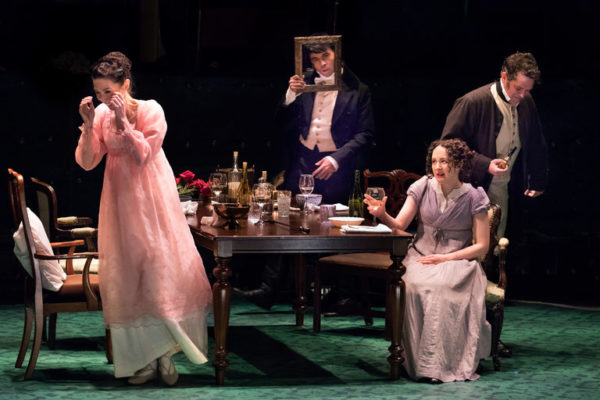
01 May TIO NYC: “Vanity Fair,” Not Fair, Excellent
“Vanity Fair,” a major hit, just extended its run again, this time through May 27, 2017, at the Pearl Theatre. GO! Tickets here.

Kate Hamill is Becky Sharp in her adaptation of Thackeray’s masterpiece. Photo courtesy TheatreMania.
The little man with a big ego and major complex seems to have stepped out of history and appears to be ubiquitous.
Strange, but true and just now bubbling to the cortical surface of my squash, there was indeed a through line to our New York visit. And it was none other than the French military leader and emperor who conquered much of Europe in the early 19th century, namely, Napoleon Bonaparte (1769-1821).
The pop opera, “The Big Comet,” a big hit on Broadway, is based on a 70-page slice of Tolstoy’s classic “War and Peace” and adapted by show’s creator Dave Malloy. The action opens in 1812, just before Napoleon’s invasion of Russia.
Napoleon invaded the Frick Museum in the works of J.M.W. Turner (1775-1851). The luminous show features a trio of port scenes, plus more than 30 oil paintings, watercolors, sketchbooks, and prints. Central to the exhibition are those watercolors, often made to be turned into a series of prints for a burgeoning class of leisure travelers in the post-Napoleonic era.
The story on both “Comet” and Turner shows here.
Then there was the production of “Vanity Fair,” based on William Makepeace Thackeray’s masterpiece.
Writing mid-19th century, Thackeray set his social satire in Regency England during the Napoleonic wars.
The climax of the novel comes with the battle of Waterloo. Unlike Tolstoy, whose “War and Peace” was influenced by “Vanity Fair,” Thackeray was supposedly squeamish about battles and blood, so he chose to leave most of the fighting, as it were, “off-stage.”
The title “Vanity Fair” comes from John Bunyan’s allegorical story, “The Pilgrim’s Progress,” first published in 1678 and still widely read at the time Thackeray’s novel was published in 1848.
Vanity Fair refers to a stop along the pilgrim’s progress: a never-ending fair held in the town of Vanity, meant to represent man’s sinful attachment to worldly things.
Thackeray’s focus is on the upwardly mobile hustler Becky Sharp and her sweet, devoted friend, Amelia Sedley, both women, at the mercy of men, hit with hard times. It is apparently not good to be poor – or even rich – if you are a member of the fairer sex during the Victorian Age.
“Vanity Fair” is considered a classic and has inspired several film adaptations.
And recently, “Vanity Fair” got a very edgy, very funny makeover in an adaptation for the stage by Kate Hamill, close on the heels of her last hit based on Jane Austen’s “Sense and Sensibility.”

Hamill’s co-conspirator is Bedlam’s artistic director Eric Tucker, who directed the production to madcap perfection.
Hamill also stars in the production as an unlikely Becky – not Thackeray’s raving beauty, rather cute and doll-like, impudent and impish – leading a seven-member ensemble.
In her remix of the original story, Hamill made some great changes. In addition to the Stage Manager and her exploration of female friendship, she’s inserted several hip, contemporary dance numbers, which are wholly unexpected, laugh out loud funny, and perfectly executed, the frantic action enhanced by Seth Reiser’s lighting, Matthew Fischer’s sound design, and Valérie Thérèse Bart’s costumes.
In a statement from the production notes, Hamill explained what she hoped to achieve with this production:
“I’m committed to reclaiming the classics for all genders. In adapting Thackeray’s novel, I wanted to write a play that provided a glimpse into a deep female friendship between two different female archetypes and the parallel paths they travel to overcome the limitations posed upon them. I also wanted the play to serve as a reminder not to judge others too harshly, because the truth is we’re all so fallible.”
And further:
“We recently witnessed, in a very concrete way, how uncomfortable our society is with ambitious women. They are always seen as unnatural and somehow untrustworthy. We need to see a story about a woman who’s ambitious – who tries to take on the world and is punished for it. Is she perfect? No, absolutely not – but the point of this play is that nobody is perfect or above reproach.”
Hamill’s Becky is a rolling stone. Mostly sympathetic, likable, and unflappable; always strategic, funny, dogged, and determined. But her character is no feminist icon. Becky’s only interests are money and social status.
The message of Hamill’s spin on the classic?
Guess.
“You can’t always get what you want. But if you try, sometimes, well, you might find you get what you need.”
As stage manager (a wonderfully diabolical Zachary Fine), a one-man Greek chorus or Shakespearian clown, points out, “there are no morals here.”

Zachary Fine is Stage manager, Mathilda Crawley, Lord Steyne.
Here being Becky – and the world that made her the way she is.
To restate the obvious, “Vanity Fair” is set in a society that cares more for good birth and good manners and money than for skill. Becky — orphaned, poor, plain, and devilishly clever — is determined to defy the odds through risky romantic entanglements, shady business practices, and climbing the social ladder at any cost. Had she been a man, she would have been described as clever and ambitious. Few would have criticized or condemned.
When Becky falls, she simply picks herself up, dusts herself off, and starts all over again.
The flinty, feisty lass simply won’t quit until the world lies at her feet.
Hello world.
But the applause is not just for Hamill/Becky. The entire ensemble – Hamill, Parsons, Fine, Sanyal, Brad Heberlee, Tom O’Keefe, and Ryan Quinn – is uniformly excellent.
Everyone nimbly executes multiple roles, displaying gender fluidity with aplomb. With just a few props – hats, shawls, apron skirts, tossed back and forth between them – the actors become fortune tellers, carnival barkers, and their aristocratic dopplegängers.
The two stand-outs among the stand-outs are Debargo Sanyal and Fine.

Debargo Sanyal is George Osborne, ‘Lesser’ Pitt Crawley, Miss Briggs, and others.
Sanyal is vain and villainous as Amelia Sedley’s beloved; simpering and sanctimonious as the religious zealot ‘Lesser’ Pitt Crawley; obsequious as the abused servant to Mathilda Crawley – who is played by Fine.
As Stage Manager, Fine is alternately hectoring – we were seated in the second row, so Clint Viebrock became his primary target to belittle – and worldly wise, breaking the fourth wall by dropping pearls before his rapt audience, we self-satisfied swine. He is imperious and intimidating as the rich bitch with the acid tongue Mathilda Crawley; lewd and lascivious as Lord Steyne. On stage – and he is a persistent presence – Fine sucks the limelight.
“A marvelous production…a show of great charm, with a sharpened feminist edge and a lively sense of contemporary relevance,” The Inquirer.
“A masterpiece of creative compression…performed to coruscatingly brilliant effect …at once arrestingly original and faithful …as big a hit as ‘Sense and Sensibility,'” The Wall Street Journal.
“I love Becky Sharp. Like ‘Sense and Sensibility’ …a gift to actors and a goody bag for its audience… a nasty tale and Becky is a nasty woman. Good for her,” The New York Times. (Full review here.)
If you find the idea of reading Thackeray’s 600+ page novel daunting, comparatively speaking Hamill’s “Vanity Fair 2.0” is fast-paced fun, running only two hours and 45 minutes. Performances are Tuesdays at 7 p.m.; Wednesdays, 2 p.m.; Thursdays, 7 p.m.; Fridays, 8 p.m.; Saturdays,2 p.m. and 8 p.m.; and Sundays, 2 p.m. and 7 p.m..
Note: We have more to look forward to from Bedlam. Rumor has it Hamill and Tucker are working their way through literature’s greatest hits.
And thanks to our friend Carol Tambor for the recommendation.
Carol is a theatre junky whose newsletter about theatrical happenings in New York and London is a must for fans. To subscribe as we have, write to carol@caroltambor.com.


Sorry, the comment form is closed at this time.